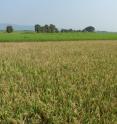Trigger found for defense to rice disease
Biologists have discovered how the rice plant's immune system is triggered by disease, in a discovery that could boost crop yields and lead to more disease-resistant types of rice. Rice is central to the food security of more than half the world's population in many of the poorest countries. But bacterial leaf blight can destroy up to 80 per cent of a crop in some countries if it develops early.
Researchers studying bacterial leaf blight have found that rice detects a molecule called RaxX secreted by the bacteria.
"We've discovered a new molecule that's never been seen before," said Dr Benjamin Schwessinger, from The Australian National University (ANU).
"We've realised that this type of molecule plays an important role in the immune response of rice plants.
"It will now be much easier to develop containment strategies against the disease and breed more robust rice plants."
The research could help the fight against similar diseases in other crops, and may even give insights into human health, as the chemistry is similar to that of HIV entering human cells.
Some strains of rice are naturally resistant to the disease, which gave the international team a clue to what was going on.
The team discovered that the rice plant's XA21 immune system is triggered when the RaxX molecule is secreted by the leaf blight bacterium Xanthomonas oryzae pv. oryzae (Xoo).
The team generated mutants of Xoo that did not produce RaxX and tested whether they triggered the rice immune response, which allowed them to isolate the Xoo gene that was creating the RaxX molecule.
Dr Schwessinger said that the chemical properties of RaxX, a tyrosine-sulfated protein, have a wider significance than just rice diseases.
"Several major human diseases, for example HIV, involve tyrosine sulfated proteins. The sulfation stabilises the molecules but its role in binding and cell entry is not precisely understood," he said.
"The new understanding could lead to the development of novel methods to block such diseases."
The research is published in Science Advances.
The publication marks a new chapter for Dr Schwessinger who was part of the team that had to retract a 2009 paper on the subject, after they found problems with their results.
"It's great to have corrected the errors," Dr Schwessinger said.
"We didn't run away from the problem, we stuck together and worked on it as a team."
Source: Australian National University
Articles on the same topic
- Rice disease-resistance discovery closes the loop for scientific integrityFri, 24 Jul 2015, 19:54:58 UTC
- Unlocking the rice immune systemFri, 24 Jul 2015, 19:54:47 UTC
Other sources
- Scientists discover rice plant's immune system triggerfrom UPIMon, 27 Jul 2015, 16:30:45 UTC
- Trigger found for defense to rice diseasefrom Science DailyMon, 27 Jul 2015, 16:30:26 UTC
- Unlocking the rice immune systemfrom Science DailyFri, 24 Jul 2015, 19:50:14 UTC
- Unlocking the Rice Immune Systemfrom Newswise - ScinewsFri, 24 Jul 2015, 19:20:17 UTC
- Rice researchers redress retractionfrom News @ NatureFri, 24 Jul 2015, 19:20:06 UTC
- Unlocking the rice immune systemfrom PhysorgFri, 24 Jul 2015, 18:50:56 UTC

